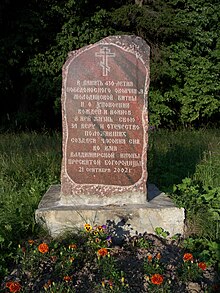Battle of Molodi
| Battle of Molodi | |||||||
|---|---|---|---|---|---|---|---|
| Part of the Russo-Crimean Wars[broken anchor] and Russo-Turkish wars | |||||||
 Molodi village. A foundation stone to commemorate the victory in the Battle of Molodi in 1572. | |||||||
| |||||||
| Belligerents | |||||||
| Tsardom of Russia |
Crimean Khanate Ottoman Empire[1] | ||||||
| Commanders and leaders | |||||||
|
Mikhail Vorotynsky (army commander) Dmitry Khvorostinin (key figure) | Devlet I Giray | ||||||
| Strength | |||||||
| 20,000[3]–70,000 men[a] | 60,000[1]–120,000[4] men | ||||||
| Casualties and losses | |||||||
| Unknown | Heavy[b] | ||||||
The Battle of Molodi (Russian: Би́тва при Мóлодях) was one of the key battles of Ivan the Terrible's reign. It was fought near the village of Molodi, 40 miles (64 km) south of Moscow, in July–August 1572 between the 120,000 horde of Devlet I Giray of Crimea and about 60,000–70,000 Russians led by Prince Mikhail Vorotynsky.[4] The Crimeans had burned Moscow the previous year, but this time they were thoroughly defeated.
Background
[edit]While the Tsardom of Russia was involved in the Livonian War, the Crimean khan hoped to make profit from the weakness of its southern borders. In the course of three expeditions, Devlet I Giray devastated South Russia and even sacked and set Moscow on fire in 1571. On 26 July 1572 the huge horde of the khan, equipped with cannons and reinforced by Turkish janissaries, crossed the Oka River near Serpukhov, decimated the Russian vanguard of 200 men, and advanced towards Moscow in order to pillage it once again.[4] Little did they know, however, that the Russians had prepared for the new invasion, setting up innovative fortifications just beyond the Oka.
Battle
[edit]The Russian forces, variously estimated at between 20,000[6][3] and 70,000 men, were placed under the supreme command of Prince Mikhail Vorotynsky.[4] Prince Repnin led the left flank, while the right flank was commanded by Prince Odoevsky. On 30 July the armies clashed near the Lopasnya River without so much as a prior reconnaissance. The fighting continued for several days, reaching its peak on 8 August. The large amount of close-in fighting made the Tatars' famed skill in archery quite useless:[4] The battle was fought principally with sabers and spears. Artillery and arquebuses were also used by the Russians to great effect. The outcome was decided by Prince Khvorostinin who bypassed the horde with his gulyay-gorod (гуляй-город) mobile fortifications and infiltrated into the rear.
Aftermath
[edit]After the battle, only 20,000 Tatar horsemen returned to the Crimea,[4] while the khan left his tent and banner on the battlefield and barely managed to escape alive. The battle claimed the lives of his sons and a grandson.
-
Moscow streltsy
-
Ivan IV is presented with trophies taken from Devlet Giray by Vorotynsky after the battle. By Boris Chorikov
-
Crimean Tatar horseman. Engraving by Abraham de Bruyn (1575)
Based on contemporary documents, the Russian forces were as follows:[7]
| Group | Composition | Number |
|---|---|---|
| Main: |
|
|
| Total: 8,255 | ||
| Right Hand: |
|
|
| Total: 3,590 | ||
| Forward: |
|
|
| Total: 4,475 | ||
| Guard: |
|
|
| Total: 4,670 | ||
| Total: 20,034 and Mikhail Cherkashenin's Cossacks (3,000—5,000) | ||
Contemporary chronicles give very large and unreliable figures when talking about the Tatar army. The Novgorod Second Chronicle gives its strength as 120,000 and the Moscow Chronicle about 150,000. According to modern Russian historians, the khan's army most likely numbered 40,000–60,000, of which two-thirds were the Crimean army proper, and the rest Nogai, Circassians and janissaries sent by the Ottoman Sultan.[1]
Notes
[edit]- ^ "Just beyond the Oka, the horde encounters 60,000–70,000 Russians, commanded by Prince Mikhail Vorotynsky…"[4]
- ^ When retreating, the remnants of Devlet Giray's army were attacked by Zaporozhian Cossacks, and only a small part of the army returned to Crimea (20,000[4]).[5] However, it is not only the battle casualties.
References
[edit]- ^ a b c Пенской В. В. "Сражение при Молодях 28 июля – 3 августа 1572 г." // История военного дела: исследования и источники. — St. Petersburg, 2012. — Vol. 2. — P. 156. — ISSN 2308-4286.
- ^ Robert Payne and Nikita Romanoff, Ivan the Terrible, (Cooper Square Press, 2002), 329.
- ^ a b "Документы о сражении при Молодях" // Исторический архив, № 4. 1959 — P. 167
- ^ a b c d e f g h Tucker 2010, p. 531.
- ^ Стороженко А. В. Стефан Баторий и днепровские козаки. Kiev, 1904. P. 34
- ^ Карамзин. История государства российского[page needed]
- ^ Документы о сражении при Молодях // Исторический архив, № 4. 1959 — P. 174–177
Sources
[edit]- Tucker, Spencer C., ed. (2010). "July 30-August 2, 1572: Eastern Europe: Russia: Battle of Molodi". A Global Chronology of Conflict: From the Ancient World to the Modern Middle East. Vol. II. ABC-CLIO.
External links
[edit]- (in Russian) http://www.hrono.ru/sobyt/1500sob/molod.html
- (in Russian) http://www.kulichki.com/moshkow/HISTORY/ANDREEW_A_R/krym_history.txt#45
- (in Russian) http://www.magister.msk.ru/library/history/karamzin/kar09_03.htm Archived 2012-07-16 at the Wayback Machine
- (in Russian) http://www.vostlit.info/Texts/Dokumenty/Russ/XVI/1560-1580/Schlacht_Molodi/text.htm
- (in English) http://www.xenophon-mil.org/rushistory/battles/ivanbook.htm



